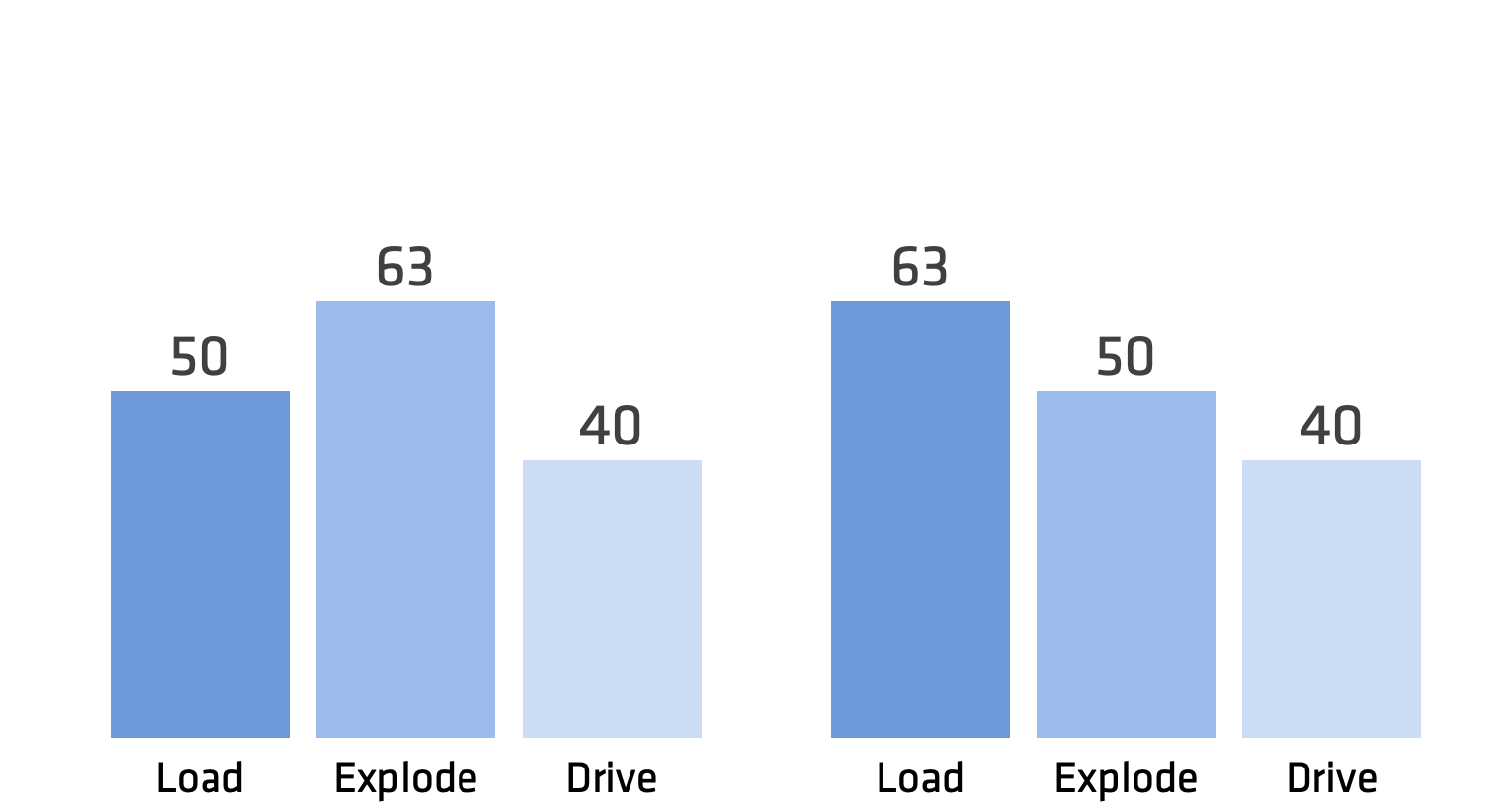Results from each Jump Scan are classified into one of five Movement Focuses that best describe their dynamic movement strategy.
Classifying Individuals by Jump Signature
When trying to understand what each variable means, it makes sense to talk about them in isolation. What is Load? What does it mean when it's high or low? What are some common characteristics? What does that imply for injury risk? What are the ways that we can influence Load? These concepts are introduced and explained in the article Load, Explode, and Drive. But the truth is, these variables and qualities aren't expressed in isolation. The combination of all of these variables makes up Jump Signature - and this is what most intuitively represents different movement qualities.
In the example below, both individuals' lowest variable is Drive, and both have a Drive of 40.

While there are some similar qualities that both individuals may share, the overall movement strategy differs between the two, as do some of the intervention strategies. The example to the left we often see in lean, explosive individuals, whereas we often see the signature to the right we see in larger, muscularly strong individuals.
So, we probably need to classify individuals further than a shared weakest variable.
Interventions Dictate Classification
Identifying ALL the possible different combinations of Jump Signatures would be an overwhelming and unnecessary task. While each individual is unique, we can (and should) create different groups, classifications, or "buckets" based on the trends and relationships we most often see. The true GOAL of classification is to provide insights and recommendations for specific exercises or interventions to affect the variables. So instead, we worked backward, utilizing the data to FIRST identify the Movement Focus classifications we are able to affect or change. There is much less utility in classifying an individual into a group that had no recommended interventions!
Internal analyses have been performed consistently to identify how these different plans affect the results from the Sparta Scans in a significant and predictable way. In 2018 an analysis from a subset of our database of 2,337 individuals over a four-year period was published in a peer-reviewed journal and is available referenced below (1). But, like what often happens when things go to print, there is actually more up-to-date information available before the ink is even dry.
As it turns out, every exercise and intervention has a combination of positive and negative effects with varying degrees of significance. For example:
- The Front Squat has a large positive effect on Load, a medium positive effect on EXPLODE, and a large negative effect on DRIVE. All of these effects were statistically significant.
- A Rear Foot Elevated Split Squat has a small negative effect on LOAD, a medium negative effect on EXPLODE, and a large positive effect on DRIVE.
Furthermore, our (and others') research has shown us that the combinations of exercises interact with each other in unique ways as well. To continue with the above examples, if we combine the Front Squat with a Rear Foot Elevated Split Squat, we are able to see a medium positive effect on LOAD, a small (and insignificant) negative effect on EXPLODE, and a large positive effect on DRIVE. This shows us that with the right combinations of interventions, we are actually able to have a positive effect on both LOAD and DRIVE simultaneously!
With this data in mind - we looked to find groupings of signatures that could be predictably influenced with consistent intervention.
The Five Jump Movement Focuses:
- Low Load
- Low Explode
- Low Drive
- Low Load & Explode
- Low Load & Drive
With an infinite number of potential possibilities, these five Movement Focuses were developed based on the information that we are able to predictably affect or change these grouping with specific interventions. A brief summary of some of the common tendencies from each classification is noted here:
Low LOAD
- Struggle to create force quickly due to a lack of strength or utilization of slower timing mechanisms.
- Avoid the use of ankles and/or knees to bend due to movement or injury history, causing individuals to bend at the waist instead.
Low EXPLODE
- Struggle to transition movements due to a lack of body control or poor strength relative to bodyweight.
- Limited core stability or strength can inhibit the efficient transmission of force between body segments.
Low DRIVE
- Struggle to get full extension of ankles, knees, and hips due to a lack of strength or mobility on the backside of the body (glute/hamstring).
- Limited mobility due to movement or injury history, causing individuals to rely on short ranges of motion.
Practical Application: At this point, it is appropriate to discuss the ability to either expand and create further classifications or simplify to create less. As always, practicality is going to dictate how simple or complex these classifications can be. In more limited situations, organizations can simply classify individuals based on a shared lowest variable, utilizing the three classes above. There are some inherent limitations to this model as all individuals with Drive as their lowest variable aren't the same. This simple classification may allow for a better end result if resources are more limited. The choice is ultimately up to the organization. While instead, some sporting organizations may create additional categories based on position or training age. Instead of having only five classifications, there may be 15 (e.g., five Movement Focuses for three different position groupings).
Regardless of the classification system utilized, it is important to understand all of the five Movement Signature classifications as individuals will fall into each of the categories.
Low LOAD & EXPLODE
- Struggle to create force quickly due to a lack of strength or utilization of slower timing mechanisms.
- Struggle to transition movements due to a lack of body control or poor strength relative to bodyweight.
Low LOAD & DRIVE
- Avoid the use of ankles and/or knees to bend due to movement or injury history, causing individuals to bend at the waist instead.
- Struggle to get full extension of ankles, knees, and hips due to a lack of strength or mobility on the backside of the body (glute/hamstring).
Common Questions:
Why can't we address Load, Explode, and Drive simultaneously?
- Check out: The "Balanced" Training Plan
Can we utilize a "corrective exercise" approach to improving Load, Explode, and Drive?
- Check out: "Corrective" Exercise
References:
- Mayberry, John K., Bryce Patterson, and Phil Wagner. "Improving vertical jump profiles through prescribed movement plans." The Journal of Strength & Conditioning Research 32.6 (2018): 1619-1626.
